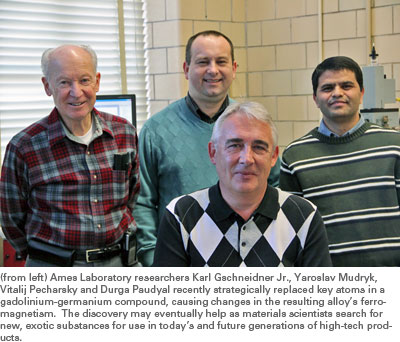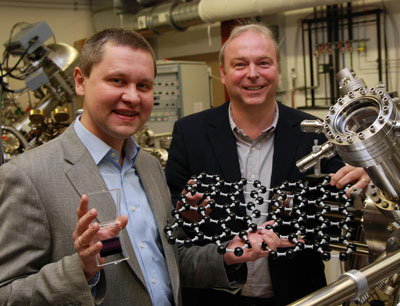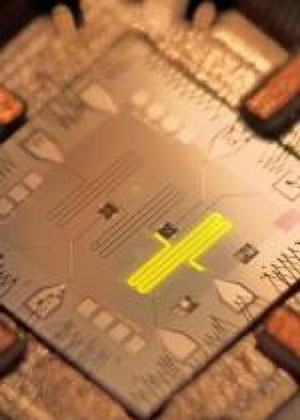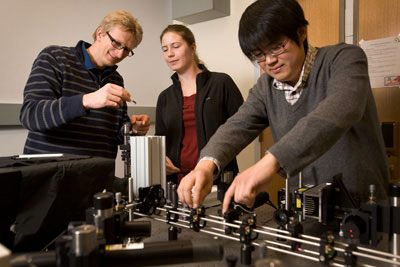The realization of topological insulators with cold atoms is extremely attractive, as it would offer an ideal quantum spin Hall effect within a laboratory. In an article recently published, an international team lay out such an experiment.
Feb 1st, 2011
Read more
Rice bioengineers, Baylor College of Medicine and Texas Children's physician-scientists zap tumors with light-activated nanoparticles.
Feb 1st, 2011
Read more
Through molecular dynamics simulations, researchers have defined the ground rules for the rotor motion of molecules attached to a gold surface.
Feb 1st, 2011
Read more
 Nine students from Chassell High School know how an atomic force microscope works. In fact, they've built a model of one out of Lego bricks. They're the members of INANO (Identifying New Academic Nanotechnology Opportunities), Chassell High School's Enterprise team.
Nine students from Chassell High School know how an atomic force microscope works. In fact, they've built a model of one out of Lego bricks. They're the members of INANO (Identifying New Academic Nanotechnology Opportunities), Chassell High School's Enterprise team.
Feb 1st, 2011
Read more
 Image sensors as used in cell phones are partially color-blind. This is because of their coating, which prevents UV light from passing through. CMOS chips have as a result not been suitable for spectroscopy up to now. A new production process makes the coating transparent - and the sensors suitable for special applications.
Image sensors as used in cell phones are partially color-blind. This is because of their coating, which prevents UV light from passing through. CMOS chips have as a result not been suitable for spectroscopy up to now. A new production process makes the coating transparent - and the sensors suitable for special applications.
Feb 1st, 2011
Read more
The electronic chips of the future might not be made of silicon or even graphene but of a material called molybdenite (MoS2). EU-funded research presented in the journal Nature Nanotechnology demonstrates that molybdenite is a highly effective semi-conductor that could be used to make transistors both smaller and more energy efficient.
Feb 1st, 2011
Read more
 The work could lead to improved methodologies for creating materials by design.
The work could lead to improved methodologies for creating materials by design.
Feb 1st, 2011
Read more
The Centre for Environmental Law Decisions and Corporate Ethical Certification (CIGA) at the University of Padua and the Institute for Technology Assessment and Systems Analysis (ITAS) at the Karlsruhe Institute of Technology, organize an international workshop titled Dilemmas of choice. Responsibility in nanotechnology development, which is aimed at presenting and debating contributions from different disciplines on several issues concerning the relationship between nanotechnology innovation and responsibility.
Feb 1st, 2011
Read more
 An der Uni Bielefeld forschen die Physiker Prof. Dr. Armin Goelzhaeuser und Dr. Andrey Turchanin intensiv an dem vielversprechenden Nanomaterial mit besonderen elektronischen Eigenschaften.
An der Uni Bielefeld forschen die Physiker Prof. Dr. Armin Goelzhaeuser und Dr. Andrey Turchanin intensiv an dem vielversprechenden Nanomaterial mit besonderen elektronischen Eigenschaften.
Feb 1st, 2011
Read more
The aim of the workshop is to bring together leaders in the emerging field of computational nanotoxicology to form an international Community of Practice for accelerated development of the science of QNTR.
Feb 1st, 2011
Read more
The aim of the workshop is to bring together scientists and engineers working on different technological uses of graphene in a multidisciplinary and multisectorial (academia/industry) environment.
Feb 1st, 2011
Read more
Stanford engineers dance with plasmonics to yield new direction for thin, inexpensive solar cells.
Jan 31st, 2011
Read more
 Inspired by the popular confidence trick known as 'shell game', researchers at UC Santa Barbara have demonstrated the ability to hide and shuffle 'quantum-mechanical peas' - microwave single photons - under and between three microwave resonators, or 'quantized shells'.
Inspired by the popular confidence trick known as 'shell game', researchers at UC Santa Barbara have demonstrated the ability to hide and shuffle 'quantum-mechanical peas' - microwave single photons - under and between three microwave resonators, or 'quantized shells'.
Jan 31st, 2011
Read more
 'Cornell Dots' -- brightly glowing nanoparticles -- may soon be used to light up cancer cells to aid in diagnosing and treating cancer. The U.S. Food and Drug Administration (FDA) has approved the first clinical trial in humans of the new technology.
'Cornell Dots' -- brightly glowing nanoparticles -- may soon be used to light up cancer cells to aid in diagnosing and treating cancer. The U.S. Food and Drug Administration (FDA) has approved the first clinical trial in humans of the new technology.
Jan 31st, 2011
Read more
Researchers at Memorial Sloan-Kettering Cancer Center's Nanotechnology Center, along with collaborators at Cornell University and Hybrid Silica Technologies, have received approval for their first Investigational New Drug Application (IND) from the US Food and Drug Administration (FDA) for an ultrasmall silica inorganic nanoparticle platform for targeted molecular imaging of cancer, which may be useful for cancer treatment in the future.
Jan 31st, 2011
Read more
Washington University in St. Louis is starting a Nanotechnology Undergraduate Education (NUE) program with a two-year grant from the National Science Foundation.
Jan 31st, 2011
Read more







 Subscribe to our Nanotechnology News feed
Subscribe to our Nanotechnology News feed